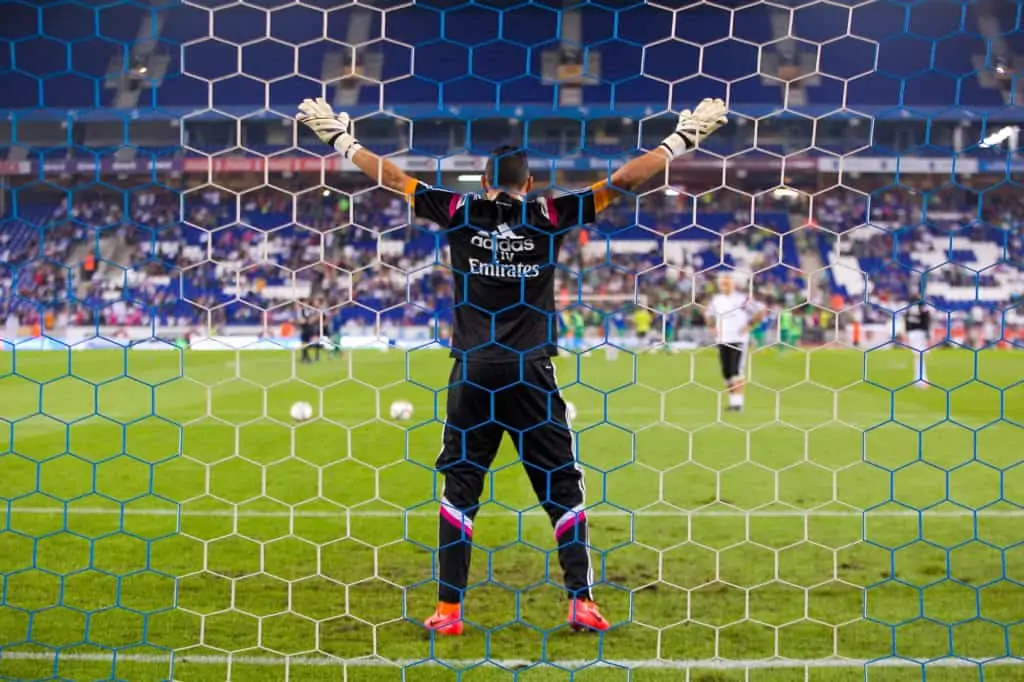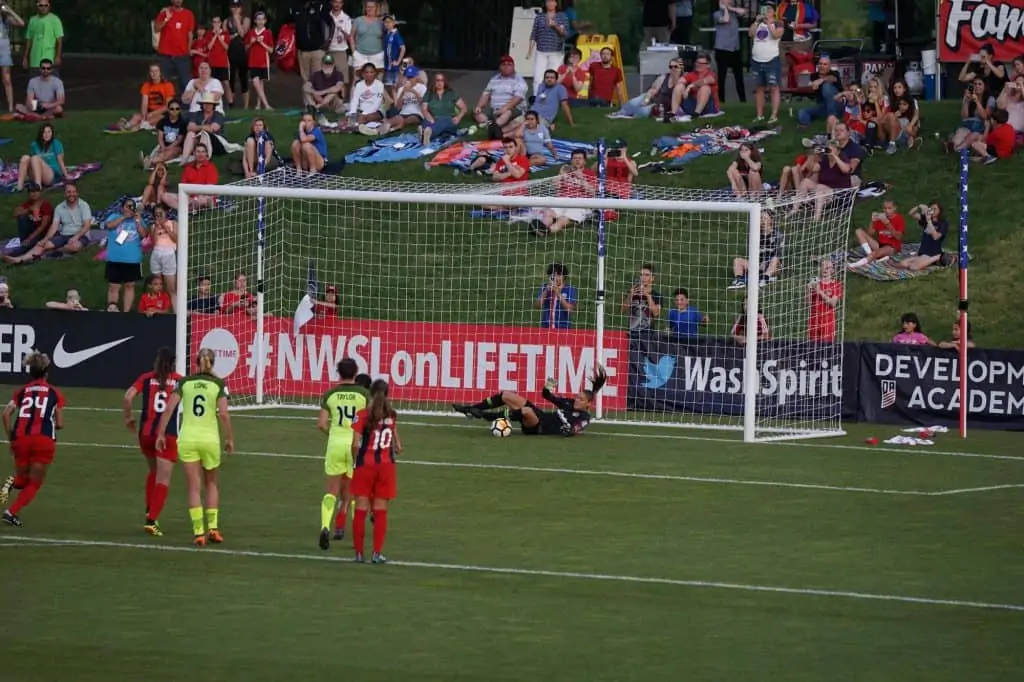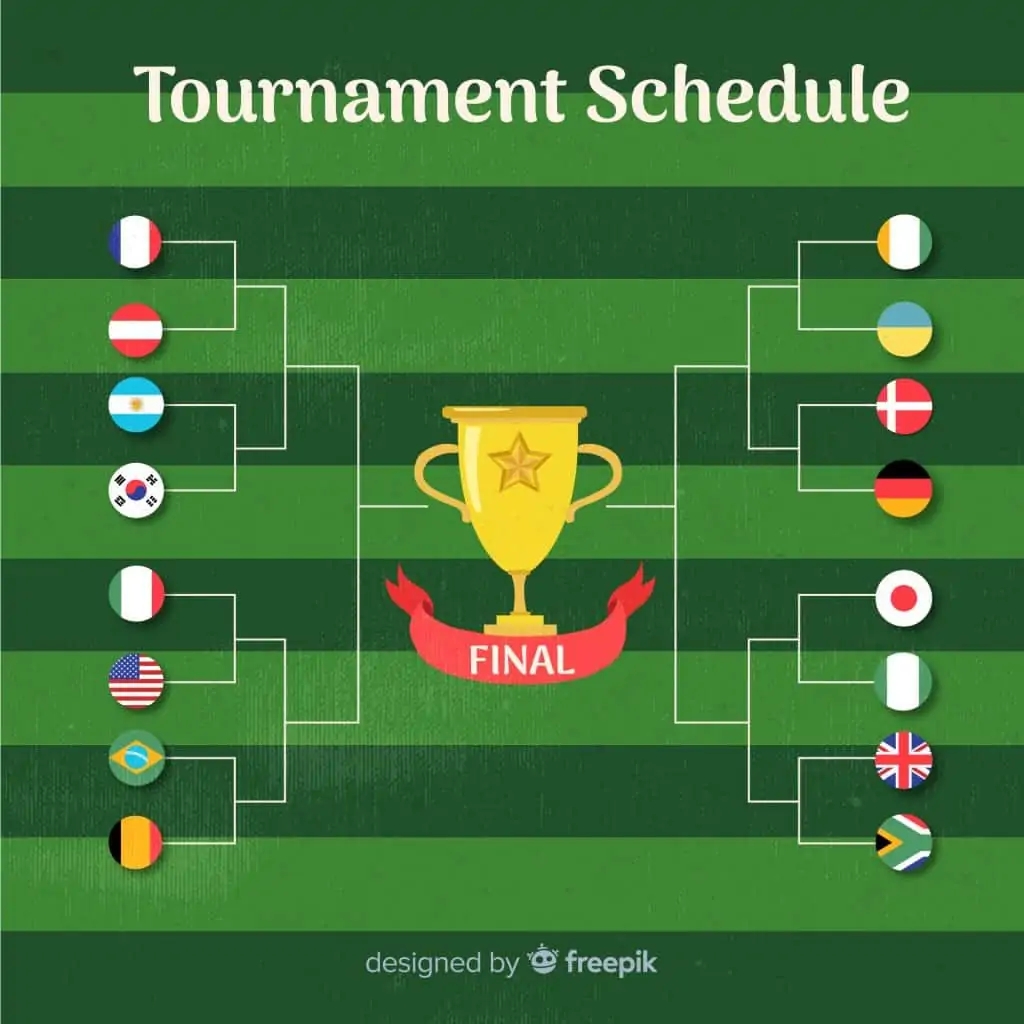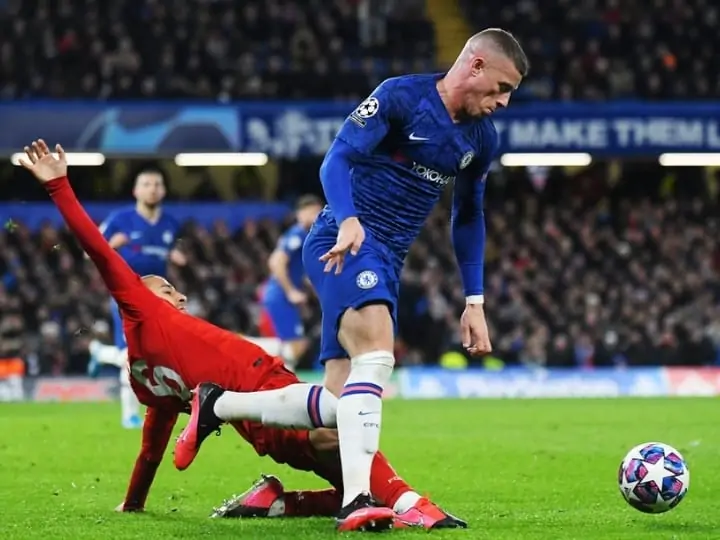Share the post "Can a Soccer Game End in a Tie? (What Happens)"
Soccer games are lower in scores than basketball, so there are often ties when playing games. The most common score in a soccer game is 1-1, a tie!
A tie in soccer is when two teams have equal goals during a game – but who wins? is the common question – there needs to be a winner! This is what we will cover in this article;
- What happens when teams tie
- Soccer Tie FAQ
- How games are decided after a tie
- How we get to penalty kicks
- MLS, EPL, ECL WC + different tie formats
- Interesting ways we used to end tied games
Not every league or competition is the same, there’s no one way to get a winner. Ties in cup games are exciting that can lead to penalties. Let’s look into each format.

- Names For Equal Goals in Soccer
- Can a Soccer Game End in A Tie?
- Soccer Tie Break and Overtime FAQ
- How Does Added Time/Injury Time Work?
- Can a soccer game end 0-0?
- What happens if a soccer game is Tied After 90 minutes?
- Equal Points in a League - End of Season (The decider)
- Replay After a Tie
- Penalty Shootout After a Tie
- Major League Soccer Tie Break
- English Premier League Tie Break
- European Champions League Tie Break
- World Cup Tie Break
- Old Ways To End a Soccer Game Tied
- Games Ending in a Tie - Concluded
Names For Equal Goals in Soccer
- Tie (0-0, 1-1, 2-2 etc.)
- Draw (0-0, 1-1, 2-2 etc.)
- Nil-Nil (0-0)
- Blank (0-0)
- Goalless (0-0)
- Zero-zero (0-0)
Note: Extra time is for knockout games that are level after 90 minutes. Extra time is normally 15 minutes a half (30 minutes total) before penalty kicks.
Can a Soccer Game End in A Tie?
Soccer can end in a tie if the scores are level after 90 minutes, plus added time. For a knockout competition, the winner will be decided in extra time or penalties.
When the soccer game is a league game and the scores are level after 90 minutes, both teams are awarded 1 point each. For the first leg in a competition, it can end in a tie and the second leg in the decider.
For a knockout competition, if the scores are level after 90 minutes, the game is decided by a replay, overtime, and/or penalty kicks. Unfortunately, my dad also explained that due to his poor planning, we’d have to miss this dramatic-sounding ending and leave immediately, in order to make the last train home…
- A tied game is a common occurrence in soccer – in fact, analysis shows that ties have become more and more common in English soccer at least, with over 25% of games ending in a draw.
But there are a number of possibilities as to what happens next if the scores are level after 90 minutes. So, to avoid our mistake and make sure you’re prepped if the scores are level at full time, here’s an explainer of everything you need to know about a tied game.
Soccer Tie Break and Overtime FAQ
How Does Added Time/Injury Time Work?
Each half of a soccer game is set for 45 minutes, although there is added time on at the end of each half. The reason for the added time is because;
- Substitutions
- Injured player treatments
- Time wasting
- Disciplinary actions
- Drink breaks (1 minute at a maximum)
- VAR checks
- Goal celebrations
During each half, the referee will add up the stoppages and decide how many minutes to add on to make up for the lost time – IFAB Law 07.
At the end of the added time, the referee will allow for a corner kick to be taken if needed and wait for the action to be away from the goal.
Players are then allowed a maximum of 15 minutes break before resuming for the second half.
During the 2016/17 EPL season there was an average of 7.59 minutes of added time – more than any other league in the world.
Can a soccer game end 0-0?
A soccer game can end in 0-0 with no goals scored for either team. For a league game, each team will be awarded 1 point for their league total. This is called a goalless draw.
Teams playing a similar system as each other can neutralize the game. If two teams like to play on the counter-attack, they normally wait for the other team to attack first.
Or, there can be two defensive teams that play each other. These teams focus on keeping out the opposition, while they wait for a chance from a freekick or corner.
These games can be dull, but there are tactical games that are interesting that end 0-0. The first of some two-legged games can end scoreless.
What happens if a soccer game is Tied After 90 minutes?
If two teams are tied over 90 minutes, teams get one point each, or there’s a replay, or penalties for the winner, or even extra time then penalties.
There are several options for what happens next. This will depend on:
- The game is part of a league or a knockout (this will affect whether a winner needs to be decided at all).
- What competition the game is part of (different competitions use different formats).
- Whether the teams have already replayed the game once (more on this below).
So, now we know that ties are a common occurrence, let’s look at the various options for settling a game.

Points for a Tie
The soccer association, FIFA has changed the way a game is ended over the years to try and introduce new exciting features. From a replay, extra time, silver goal, golden goal, and penalties.
Shared points after a tie
The point system for all of the leagues is 1 point for a tie and 3 points for a win. This system changes when teams are in the playoffs for the championship or a tournament.
If the game is part of a league – either a standalone tournament or a group stage as part of a bigger tournament – then a tie usually results in the two teams sharing the points.
This means both teams are awarded one point each towards their league total, rather than three points which would usually be given to a team winning a game.
In this case, the game simply ends at 90 minutes as there’s no need to settle the outcome.
Equal Points in a League – End of Season (The decider)
In the MLS, the decider of the league is by a knockout stage. So the following applies to qualification and other leagues in the world.
Where teams are level on points within a league, there are several ways of separating them. Most commonly, teams are ranked by goal difference (the number of goals you’ve scored minus the number you’ve conceded).
If this is also tied, they’re separated by
- the number of goals scored (to reward attacking play).
- If both these things are also equal (this would happen, for example, if teams have only played one game, against each other, and drawn it) they may temporarily be separated by alphabetical order.
- If teams have identical records over a whole season (which is incredibly unlikely) a one-off tie-breaker game may be used.
While teams have never finished with identical points and goal records in any of the major soccer leagues, a tie-breaker was used to decide the 1963-64 Italian league title.
Before they had introduced the goal difference rule. Bologna beat Inter Milan 2-0 in a tiebreaker game to seal the title.
Replay After a Tie
So, a tied game is relatively straightforward if it’s part of a league format – but what if it’s part of a knockout cup competition?
Teams aren’t playing for points, so we need some way of deciding who should progress to the next round. One way of doing this – used in the English FA cup for example – is simply to replay the game.
- This usually happens a week or so later, depending on the scheduling of other fixtures, and commonly happens at the opposing ground (so the team with home advantage is reversed).
Nowadays, competitions usually only allow one replay, to avoid fixture congestion. If the replay also ends in a tie, one of the methods below is then adopted.
- But this wasn’t always the case. In 1989, two English sides – Newcastle and Watford – played 4 times in 11 days before a winner could be found!
Overtime to Decide a Tie
Probably the most common method for settling tied games in a cup competition is through a 30-minute period of overtime – also referred to as ‘extra time’.
This simply means teams playing for 30 additional minutes (made up of two 15-minute halves) to see if one team can outscore the other. Standard overtime continues for the full 30 minutes, regardless of how many goals are scored in this period, with teams switching ends after 15 minutes.
In 2010, England’s Leyton Orient scored 6 extra-time goals to beat non-league Droylsedon 8-2 after overtime, even though the game had been tied after 90 minutes!
But what happens if teams are still tied after an extra 30 minutes? This is one of the most dramatic events in soccer.

Penalty Shootout After a Tie
Perhaps one of the most exciting events in soccer – is the PK shootout. Each team selects 5 players (who must all have been on the field at the full-time whistle) to try and score from 12 against the opposing keeper.
After 5 kicks, the team that has scored the most wins. If still level after 5 kicks, they continue until one team scores and the other team misses. This truly is a chance for heroes and villains to be formed, with every kick and every rejection taking on huge significance.
Teams used to take it in turns to take PKs (so kicks would be taken alternately by team A, team B, team A, team B) but increasingly tournaments are using an ABBA method.
This means team A takes one kick, then team B takes two kicks, then team A takes two kicks, and so on. Science shows that teams taking their kick first have a slight psychological advantage, so this new approach is an attempt to even that out.

Teams Level After 5 Penalty Kicks
If teams still can’t be separated after 5 PKs each? Then the drama ratchets up again as we move into a ‘sudden death’ shootout. This means teams take a further one PK each, until only one team scores.
Importantly, individual players can only take one PK in a shootout, until every other player in the team has also taken at least one (so if your best striker takes the first PK,
He can’t take another until the whole team has taken at least one). This means that as the shootout goes on, players less and less confident taking penalties are required to step up.
There are often added drama as goalkeepers end up facing off – one trying to score a PK against their opponent
Top Penalties Scored by Goalkeepers
Sudden death PKs are rare, and shootouts are usually settled relatively quickly, but they can occasionally go on and on – getting more and tenser.
In the semi-final of the 2006 African Nations Cup, Ivory Coast beat Cameroon 12-11 after a total of 24 PKs!
Major League Soccer Tie Break
A league match in the MLS has the same scoring system, 1 point for a tie and 3 points for a win.
Playoffs

From 2019, the top 7 teams progress to the playoffs. There is one match in the play-off rounds, unlike before when there were two legs. The team that finished the highest in their conference progressed to the semi-final.
The highest seeding team hosts the game. During the playoffs, if a game ends in a tie after 90 minutes, there is extra time. The extra time will be two halves of 15 minutes and if one team scores more than the other, they win.
If the game is still a tie after 120 minutes, the teams will have a penalty shootout.
Read more about the MLS in this MLS Explained article – how the league works.
English Premier League Tie Break
League
Points are given the same for a league match, 1 for a tie and 3 for a win. In the EPL there are no playoffs, so the team with the highest points at the end of the season wins the league.
If two teams are tied with the same point after all the games are played. The team that has the best goal difference wins. If the teams have the same goal difference, it goes to the team that scored the most in the season.
Cup Games
FA Cup
The matches that end in a tiebreak up to the fifth round, have a replay. If the teams are still tied after 90 minutes, the teams go to extra time and then on to penalties.
The games after the fifth round, do not have a replay – this is to reduce the number of games. To finish the game in a tiebreak, the normal extra time and penalties will conclude it.
League Cup
All games apart from the final will not have extra time If the teams are tied. At the end of a tied game, there will be penalties to decide the winner. The final will have extra time and penalties if the game is tied.

European Champions League Tie Break
The Champions League begins with a league format. 4 teams in each league, the teams play each other home and away. Teams are awarded 1 point for a draw and 3 points for a win.
After the league format is finished, the teams are picked from a draw to play each other. Teams from the same leagues or the same countries cannot play each other in the first knockout round.
The teams in the eliminators will play against the team they draw twice, home and away. The first team picked out of the draw will play at home first. In the second game, if the teams are tied, the team that scored more away goals will win.
Champions League ECL New Rules 2022
Previously (as below) in the knockout stages of the ECL, if a team scored more goals away from home than the opposition, they would win if the game ended in a tie.
The rules for 2022 onwards have removed this rule so there are no advantages in scoring away from home. If the teams are level after both games, the tie goes into extra time and then on to penalties if the scores are still level.
Although the away goal rule made for an interesting format – tactical play to stop the opposition from scoring away from home. The rule also made the team more reserved, which would result in fewer goals being scored.
This new rule or the traditional rule will encourage teams to play more attacking when they are playing away from home. So hopefully more goals to see in the future.
Home and Away Aggregate Score = Away Goal Rule (Old Rule)
| Manchester United | Barcelona | |
| First Match | 3-1 | |
| Second Match | 2-4 |
The final score added is; Manchester 5-5 Barcelona.
Both the teams scored the same amount of goals, but because Manchester United scored 2 away goals and Barcelona scored 1 away goal, United progressed to the next round.
If the teams score the same amount of goals as each other, eg. 2-2 and 2-2. The second game would go to extra time after 90 minutes, then a penalty shootout.
The final is a similar format to the other competitions. If the teams are tied after 90 minutes, extra time is played. If a team scores more than the other team in the 30 minutes of extra time, they win.
After 120 minutes if the teams are still tied, it goes to penalties.

World Cup Tie Break
The World Cup start with group stages, mini-leagues similar to the Champions League. With 1 point for a tie and 3 points for a win. The teams that qualify from the group stages go into the playoffs. The playoffs are one game and if the teams are tied after 90 minutes, they play overtime.
If a team scores more in overtime, they win the game. If it’s still tied, they go on to have a penalty shoot-out.
Old Ways To End a Soccer Game Tied
The final two methods of settling a tied game are now largely consigned to history. The first experiment, golden goal, was a variation on standard overtime.
Golden goal rule
If a game ended in a tie break there would be a 5-minute break. Teams would enter the field and like normal, there are two halves of 15 minutes. The first team to score in overtime wins the game = Golden Goal. If no team scores in overtime, the teams would have penalty kicks at the end like normal.
Rather than simply playing out a further 30 minutes, teams would simply play until one team scored. Whenever this happened, the game would end immediately and the goal would win the game.
Perhaps the most famous example of this was in the final of the 2000 European Championship, with France beating Italy via a golden goal. If no goal was scored in 30 minutes, teams would face a PK shootout.
While the golden goal has now been abolished by FIFA and is no longer used in major international tournaments, it’s still used in some more minor tournaments, for example in NCAA soccer championships.
Silver Goal
This meant that if a goal was scored during overtime, teams would continue to play until the end of the 15-minute half. A further variation – called the silver goal – was briefly used by UEFA, perhaps most famously in the 2004 European Championships.
So, if a team scored 10 minutes into overtime, the opposing team would have 5 minutes – until half-time – to find an equalizer. If they managed to do so, the second half would be played; if they failed, the game would end at halftime.
This format was felt by many to be confusing and arbitrary – most famously when the Czech Republic lost to a Greece goal scored after 105+1 minutes (the very end of the premier half of overtime).
This highlighted the drawbacks of silver goals and the format was abolished soon after.
Games Ending in a Tie – Concluded
So, there we have it: yes – soccer games absolutely can finish in a tie. In league games, this usually isn’t a problem, with teams simply sharing the points between them.
However, when the game is part of a knockout competition and a winner is needed, there are a variety of ways of deciding the outcome.
From overtime to PK shootouts, tied games can often give us the most famous and dramatic endings. So, make sure you know which format applies to your favorite tournament – after all, you don’t want to miss the last train home after discovering that an extra 30 minutes is needed to settle the outcome!
I do like the systems that encourage teams to score more. Some proposals have been to replace the penalty shoot-out with another system.
After extra time, a player will dribble the ball towards the goal and shoot and the goalkeeper will be able to move into their box is one idea. Although a penalty shoot-out is great, only when you win!
Share the post "Can a Soccer Game End in a Tie? (What Happens)"
Joel is a seasoned soccer journalist and analyst with many years of experience in the field. Joel specializes in game analysis, player profiles, transfer news, and has a keen eye for the tactical nuances of the game. He played at various levels in the game and coached teams - he is happy to share his insight with you.



